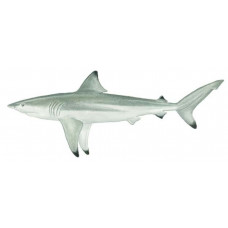Latin name
Carcharhinus limbatus
Other names
Blacktip whaler, common blacktip shark, small blacktipped shark.
Identification
Dark bluish-gray on the back and whitish underneath, with a distinctive silvery-white stripe on each side. Young fish tend to be paler. As the name implies, it has black tips on the inside of the pectoral fins, as well as on the dorsal and anal fins, and on the lower lobe of the caudal fin in young fish. This streaking may be faint, especially on the first dorsal fin, and it disappears as it grows. Blacktip sharks have a long, almost V-shaped snout and jagged, almost symmetrical teeth.
Distribution
A widespread species, it extends along in the western Atlantic Ocean from Massachusetts to Brazil, and in the east from Senegal to Zaire, Madeira, the Canary Islands, and the Mediterranean. In the eastern Pacific, it is found from southern Baja California to Peru and the Galápagos Islands.
Habitat
It often forms large surface schools and is an active hunter in the middle layers of water. It makes very few attacks on humans, but is dangerous when provoked.
Size
Blacktip sharks reach just over 8 feet in length. The world record in tackle is a fish weighing 270 pounds 9 ounces, caught off the coast of Kenya in 1995.
Life history and Behavior
No information
Food and feeding habits
No information
Reproduction
No information
| Classification | |
| Phylum | Chordata |
| Class | Chondrichthyes |
| Squad | Carcharhiniformes |
| Family | Carcharhinidae |
| Genus | Carcharhinus |
| Species | C. limbatus |
| Features | |
| Conservation status | Vulnerable |
| Habitat | Littoral |
| Life span, years | 12 |
| Maximum body weight, kg | 123 |
| Maximum length, cm | 280 |
| Sailing speed, m/s | 6.3 |
| Threat to people | Edible |
| Way of eating | Predator |




